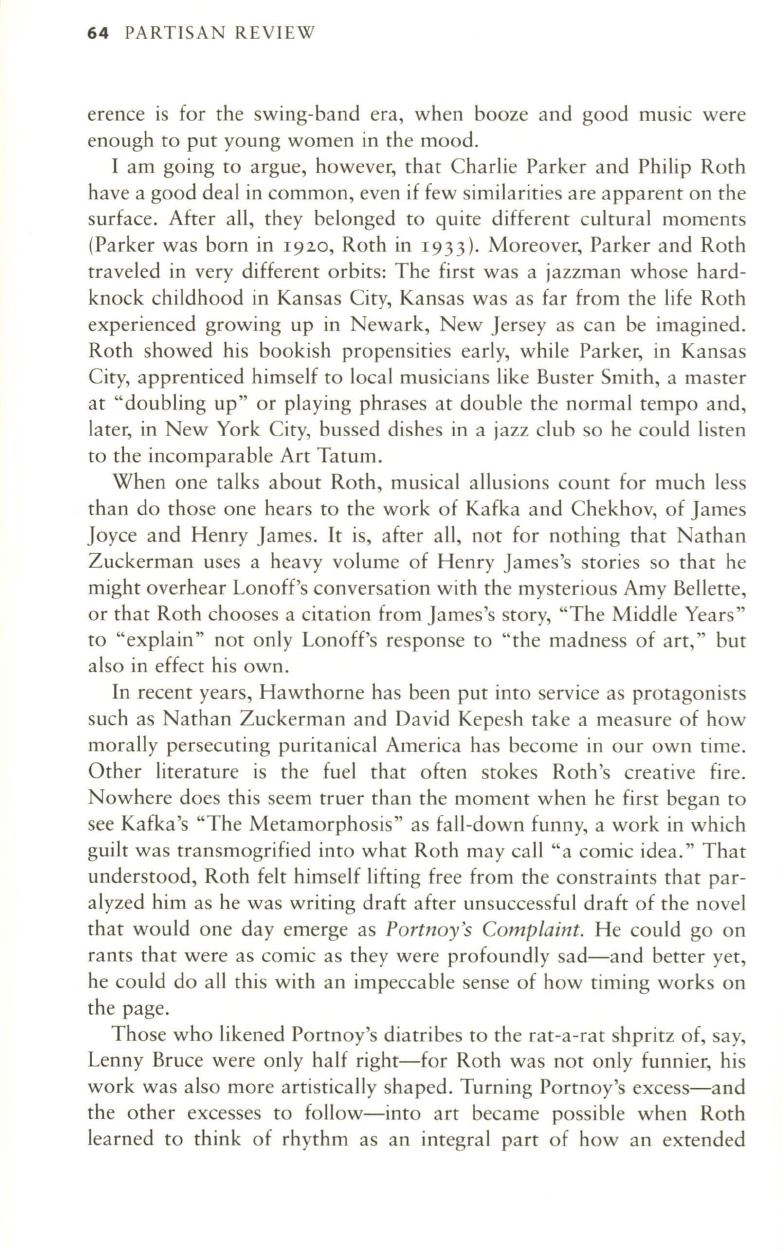
64
PARTISAN REVIEW
erence is for the swing-band era, when booze and good muslC were
enough to put young women in the mood.
I am going to argue, however, that Charlie Parker and Philip Roth
have a good deal in common, even if few similarities are apparent on the
surface. After all, they belonged to quite different cultural moments
(Parker was born in
1920,
Roth in
1933).
Moreover, Parker and Roth
traveled in very different orbits: The first was a jazzman whose hard–
knock childhood in Kansas City, Kansas was as far from the life Roth
experienced growing up in Newark, New Jersey as can be imagined.
Roth showed his bookish propensities early, while Parker, in Kansas
City, apprenticed himself to local musicians like Buster Smith, a master
at "doubling up" or playing phrases at double the normal tempo and,
later, in New York City, bussed dishes in a jazz club so he could listen
to the incomparable Art Tatum.
When one talks about Roth, musical allusions count for much less
than do those one hears to the work of Kafka and Chekhov, of James
Joyce and Henry James.
It
is, after all, not for nothing that Nathan
Zuckerman uses a heavy volume of Henry James's stories so that he
might overhear Lonoff's conversation with the mysterious Amy Bellette,
or that Roth chooses a citation from James's story, "The Middle Years"
to "explain" not only Lonoff's response to "the madness of art," but
also in effect his own.
In recent years, Hawthorne has been put into service as protagonists
such as Nathan Zuckerman and David Kepesh take a measure of how
morally persecuting puritanical America has become in our own time.
Other literature is the fuel that often stokes Roth's creative fire.
Nowhere does this seem truer than the moment when he first began to
see Kafka's "The Metamorphosis" as fall-down funny, a work in which
guilt was transmogrified into what Roth may call "a comic idea." That
understood, Roth felt himself lifting free from the constraints that par–
alyzed him as he was writing draft after unsuccessful draft of the novel
that would one day emerge as
Portnoy's Complaint.
He could go on
rants that were as comic as they were profoundly sad-and better yet,
he could do all this with an impeccable sense of how timing works on
the page.
Those who likened Portnoy's diatribes to the rat-a-rat shpritz of, say,
Lenny Bruce were only half right-for Roth was not only funnier, his
work was also more artistically shaped. Turning Portnoy's excess- and
the other excesses to follow-into art became possible when Roth
learned to think of rhythm as an integral part of how an extended


